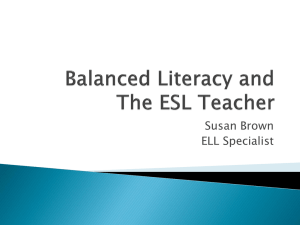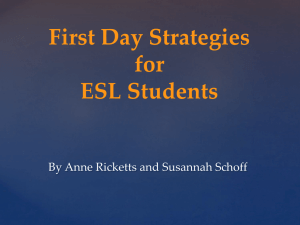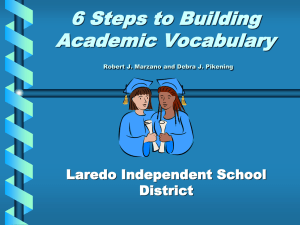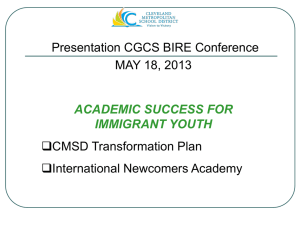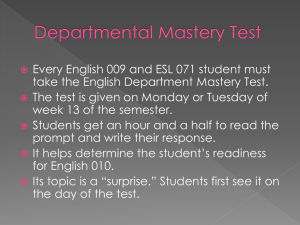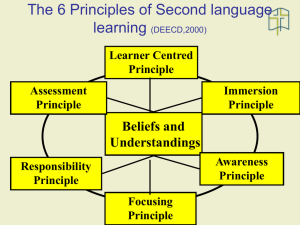The International Newcomers Academy
advertisement
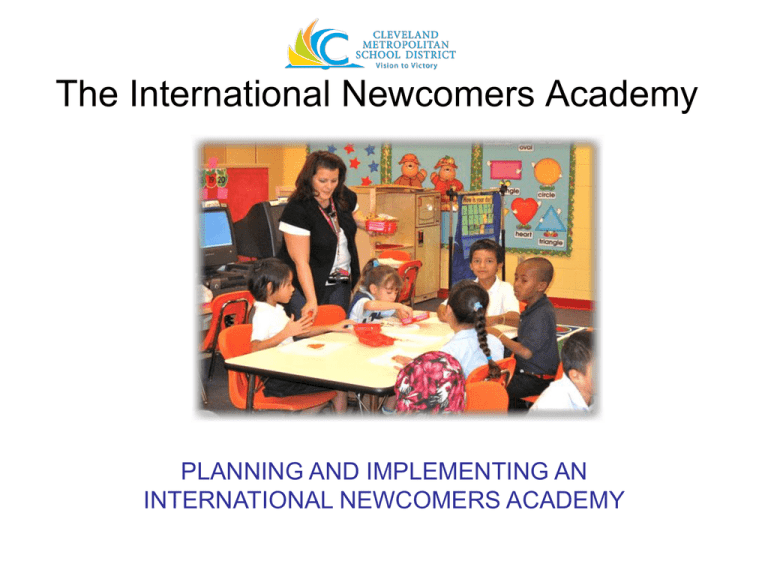
The International Newcomers Academy PLANNING AND IMPLEMENTING AN INTERNATIONAL NEWCOMERS ACADEMY CMSD LEP ENROLLMENT School Year Average Daily Student Enrollment Black, nonHispanic Asian or Pacific Islander 2009-2010 46,697 69.0% 0.6% 2010-2011 47,962 68.2% 2011-2012 42,772 68.2% Hispanic MultiRacial White, nonHispanic Limited English Proficient Students with Disabilities 12.2% 3.1% 14.8% 5.5% 22.3% 0.6% 12.3% 2.2% 14.6% 6.0% 21.6% 0.7% 10.0% 2.6% 17.8% 6.2% 21.1% Research Findings Current research identified six major challenges for improving the literacy of ELLs: Lack of common criteria for identifying ELLs and tracking their academic performance Lack of appropriate assessments Inadequate educator capacity for improving literacy in ELLs Lack of appropriate and flexible program options Inadequate use of research-based instructional practices Lack of a strong and coherent research agenda about adolescent ELL literacy Report to the Carnegie Corporation of New York: Double the Work- Challenges and Solutions to Acquiring Language and Academic Literacy for Adolescent English Language Learners, published by the Alliance for Excellent Education in 2007, authored by Deborah J. Short and Shannon Fitzsimmons. Possible Solutions Newcomers students need specialized programs to accelerate their learning of English, their acculturation to U.S. schooling practices, and access basic content knowledge. Research based recommended program features include: Intensive courses to integrate students and fill gaps in educational background. Sheltered instruction or bilingual education coupled with contentbased ESL classes Length of enrollment based on individual needs Staff selection process to ensure highly-qualified staff Flexible pathways for graduation and careers CMSD International Newcomers Academy Goals: Accelerate English language acquisition in the four domains of listening, reading, speaking and writing Develop academic content vocabulary and higher level thinking skills Deliver high-quality academic core content instruction Promote the development of crosscultural social and academic skills students will need when entering district mainstream schools Develop a strong interdisciplinary foundation for long-term academic and socio-cultural success Develops strong family and community links that will foster cultural acclimation and positive family school and community engagement Program Objectives: Students’ attainment of English as Second Language skills based on State Standards within one to two school years Achieve academic gains of a minimum of one grade level in core academic content areas Provide a flexible instructional curriculum that responds to students’ bilingual language and cultural needs Increase cultural exposure through varied activities Students will develop learning strategies and self-awareness for achieving success Provide students a comprehensive support system in collaborations with internal and external providers via Humanware initiatives Provide opportunities to effectively acclimate parents and families to the community and to it’s available resources CMSD- Newcomer Definition and Entrance Criteria A newcomer is a non English-speaking student who scores at the beginning level on the English language placement test and has been in the U.S. for no more than one school year. INTERNATIONAL NEWCOMERS ACADEMY STUDENT REPORT BY GRADES GRADE TOTAL PRE-K 18 K 40 1 28 2 25 3 21 4 22 5 23 6 15 7 27 8 20 9 32 10 25 11 19 12 5 TOTALS 320 STUDENT DEMOGRAPHICS GENDER CITIZEN STATUS ENROLLMENT DATE FEMALE REFUGEE ONE YEAR 46% 31% 90% MALE IMMIGRANT TWO YEARS 56% 46% 10% BORN IN PUERTO RICO 42% LANGUAGE SPANISH= 58% ARABIC=12% NEPALESE=10% 20% Other Languages Amharic Burmese Chinese Dinka French Hindi Japanese Karen Kirundi Pul Romanian Russian Swahili Tagalog Tigrinya Vietnamese STUDENT ENROLLMENT STUDENT BY LAU CODES SY 2011-2012 STUDENT BY LAU CODES 9% LAU A 91% LAU B This is what we do Instructional Design Use of ESL research based practices and principles primarily utilizing sheltered English instructional methods and materials. Use of Sheltered English instructional strategies and SIOP in the teaching of core content along with native language support. In the Classroom • • • • 5, 40 min. periods of ESL daily RIGOR English Reading Program SIOP Method used in all content areas Marzano’s Teaching Basic and Advanced Vocabulary Resources • • • • • • RIGOR Spotlight On English Imagine Learning English in a Flash Accelerated Reader First in Math Instructional Design All students (Pre-K -12) follow an elementary program master schedule based on forty minutes instructional periods. Students are also grouped into one of two ESL levels (A and B) based on their English proficiency levels and assigned to self-contained classes by grade bands ESL Level A: Students at pre-functional level in English language acquisition and/or read in English at the pre-literate level Students receive 5 periods of ESL/ELA, 1 period of math, and 1 period of an elective ESL Level B: Students with native language literacy skills and/or read in English at the early literacy or above 3rd grade level Students receive 4 periods of ESL/ELA, 1 period of math, 1 period of an elective, 1 period of Sheltered English instruction integrating science and social studies. Instructional Design Project based learning and Global studies are integrated school wide in the academic subjects to build on students’ prior knowledge and experiences Students move through the proficiency levels at varying rates based on classroom performance, motivation, ongoing assessments and teacher observations. A balanced literacy program is provided during the ESL/ELA instructional block. Use of direct and indirect instruction, cooperative flexible grouping, learning centers, rich language and student interaction activities to supports vocabulary development Use of technology lab and resources to support and practice reading, speaking and listening skills. CHALLENGES VERTICAL DESIGN 2010-11 2011-12 Pre-K Pre-K K K 1-2 K 3-4 1-2 5-6 2-3 7-8 3-4 9-12 English/ESL 4-5 9-12 Social Studies 5-6 9-12 Math 7-8 ESL Resource 10-12 Science 1/2 Music 10-12 English/ESL 1/2 P.E. 10-12 Science 1/2 Art 7-12 Social Studies MEDIA 7-12 Math MEDIA 1/2 Music 1/2 P.E. 1/2 Art ESL Resource 9 English/ESL CHALLENGES NEW INCOMING STUDENTS DAILY TESTING ACCOMMODATIONS SPECIAL EDUCATION GROWING PAINS STAFFING: CONTRACT ISSUES INTERVIEWS DISTRICT ECONOMIC SATUS=LAYOFFS PROFESSIONALLY DEVELOPED STAFF EXIT CRITERIA: PARENT PUSH BACK • • • Assessments District and State standardized tests: OTELA, OAA, OGT and CMSD Benchmark Tests Resource Specific Assessments: English in a Flash, STAR Reading, Accelerated Reader, First in Math skills logs. Authentic Assessments: Portfolios, Video for reading fluency. Video Recording • • Provides a way for evaluating reading fluency, pronunciation and intonation Reading Fluency Rubric used for evaluation. Exit Criteria The decision to exit a student from the Newcomer program follows a standardized procedure Teacher recommendations Formal and informal observations English-Language Development Observation Checklist, Standardized test scores –OTELA & Benchmark tests Student’s portfolio of class work Parent Conference/Contract Paths to Graduation for Secondary Newcomer Academy Students Newcomers Grades 6 - 8 Newcomers grades 9-12 /Bilingual Program Schools Grades 6, 7, OR 8 Ninth Grade Thomas Jefferson Grade 9 Five year alternatives pathways for high school overage students OR Other Schools of Choice Comprehensive High Schools with support Grades 10-12 OR Other CMSD High Schools Provides , sheltered instruction in content subjects and bilingual tutorial support with academic credit leading to HS diploma. Provides counseling and linkage to targeted postsecondary and career + technical programs for students unable to graduate by age 21. Referral to Career + Technical training, credit retrieval, GED for 17-21 year olds with low credits Support Intervention Components Student Transition Activities Support to schools, collaboration with staff, students, parents and administrators. Discussion and end of year pre-preparation activities or conferences by all staff with parents and students. Students make visits to the receiving school and classrooms. Students are transitioned into ESL/Bilingual classrooms at the designated home school. Orientation activities provided by the receiving school to ensure that the newcomer students are provided appropriate information to allow them to access appropriate courses and make decisions about postsecondary options. Support Intervention Resources Parent Engagement Outreach and parent engagement activities will be implemented to improve the whole family’s successful integration to the new community and culture. (Workshops, socials, community trips etc.) Collaborations with community partners will be established to support and address the financial, educational and health needs of families. Health screening and referrals to therapeutic services for all students who need additional care. Support to break cultural barriers to help parents understand how schools function and provide them with the information and assistance they need to support their children’s education. Support Intervention Resources Multilingual Welcome Center services- (in the same school location) Community Collaborations for student and family services After school tutoring programs to support students' academic achievement and increase interactions with native English speakers Summer enrichment school offerings in partnerships with community partners Professional & Committed Staff Commitment to a school wide philosophy of research best practices for English as a second language instruction and academic outcomes for ELLs... Implement collaborative professional learning community standards focused on improved student learning . Engage in common planning time (3 to 5 hours/week) to support team collaborations, curriculum development and alignment of curriculum based on student needs, and to monitor student progress using data. Participate on ongoing job-embedded professional development on a monthly basis along with opportunities to evaluate student growth and progress effectiveness. ( 50 hours of summer preservice & after-school) OHIO TEST OF ENGLISH LANGUAGE ACQUISITION (OTELA) PERCENTAGE OF STUDENTS BY PROFICIENCY LEVEL GR. KDG LISTENING 30% 35% 1 2 3 35% GR. KDG SPEAKING 15% 40% 1 2 3 45% OHIO TEST OF ENGLISH LANGUAGE ACQUISITION (OTELA) PERCENTAGE OF STUDENTS BY PROFICIENCY LEVEL GR. 1-2 LISTENING GR. 1-2 SPEAKING 21% 32% 32% 37% 1 1 2 2 3 3 42% 37% GR. 3-5 LISTENING GR. 3-5 SPEAKING 7% 2% 20% 1 34% 24% 1 2 3 39% 4% 3 4 4 5 33% 2 5 26% 11% OHIO TEST OF ENGLISH LANGUAGE ACQUISITION (OTELA) PERCENTAGE OF STUDENTS BY PROFICIENCY LEVEL GR. 6-8 LISTENING GR. 6-8 SPEAKING 6% 19% 35% 17% 1 1 2 2 3 3 4 4 5 5 23% GR. 9-12 LISTENING 9% GR. 9-12 SPEAKING 7% 17% 16% 1 28% 1 2 29% 2 3 16% 4 4 5 5 17% 39% 3 22% •SCHOOL YEAR 2010-11-INA@THOMAS JEFFERSON SCHOOL YEAR 2011-12 INA@THOMAS JEFFERSON •SY 2009-2010 JOSEPH M. GALLAGHER SCHOOL YEAR 2010-11INA@THOMAS JEFFERSON •SY 2010-2011 JOSEPH M. GALLAGHER •SCHOOL YEAR 2009-10 LINCOLN COMMUNITY WRAPARROUND •SCHOOL YEAR 2010-11 LINCOLN COMMUNITY WRAPAROUND •SCHOOL YEAR 2009-10-LINCOLN PROGRAMMING AND SOFTWARE •SCHOOL YEAR 2010-11-LINCOLN PROGRAMMING AND SOFTWARE •SCHOOL YEAR 2009-10-LINCOLN INTERNATIONAL STUDIES •SCHOOL YEAR 2010-11-LINCOLN INTERNATIONAL STUDIES Accelerated Reader Data Accelerated Reader Data Questions? Contact Information Natividad Pagan: Director, Multilingual Multicultural Education Natividad.Pagan@cmsdnet.net (216) 574-8584 Rhonda A. Corr Saegert: Principal, International Newcomers Academy Rhonda.Saegert@cmsdnet.net (216) 404-5111 Margaret Berrios-Brown:Academic Coach Margaret.berrios.brown@cmsdnet.net (216) 224-1547 The International Newcomers Academy 3145 West 46th Street, Cleveland, OH 44102 (216) 404-5098


